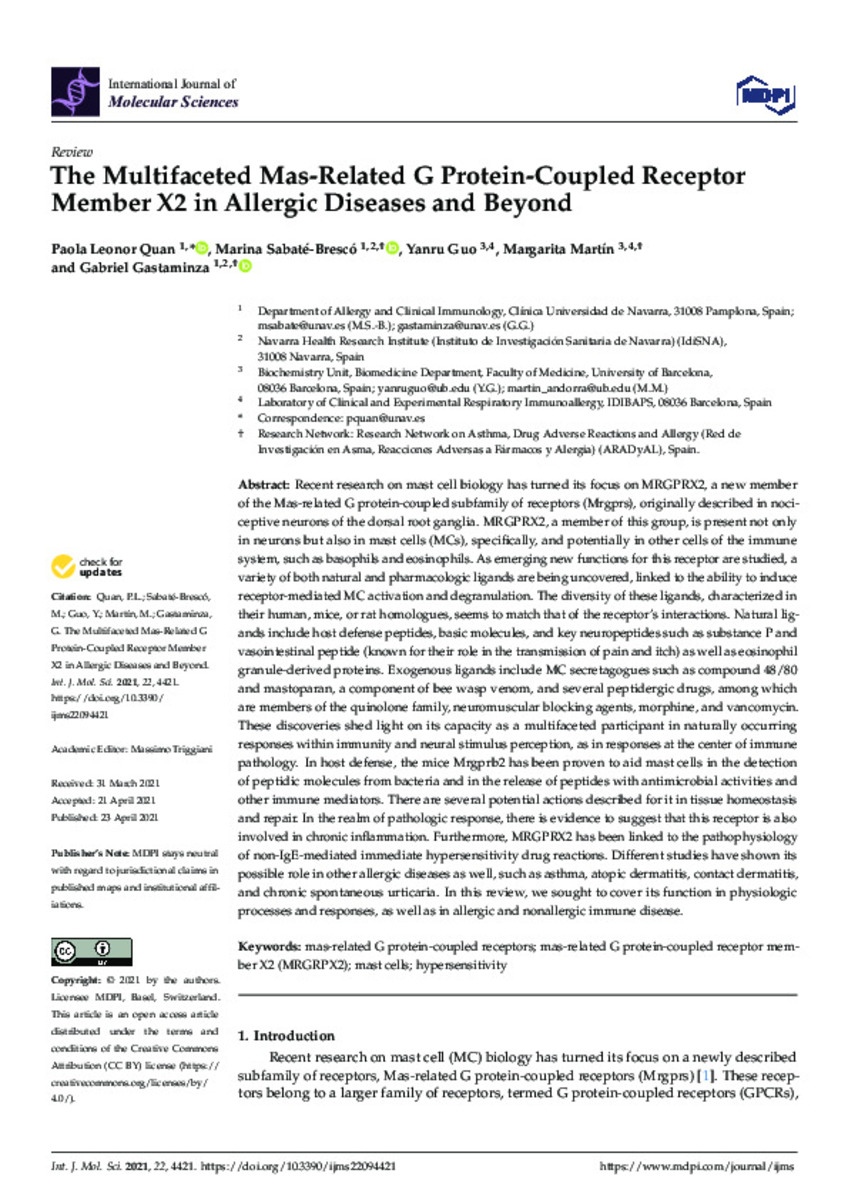Full metadata record
| DC Field | Value | Language |
|---|---|---|
| dc.creator | Quan, P.L. (Paola Leonor) | - |
| dc.creator | Sabaté-Brescó, M. (Marina) | - |
| dc.creator | Guo, Y. (Yanro) | - |
| dc.creator | Martín, M. (Margarita) | - |
| dc.creator | Gastaminza, G. (Gabriel) | - |
| dc.date.accessioned | 2024-04-17T07:36:39Z | - |
| dc.date.available | 2024-04-17T07:36:39Z | - |
| dc.date.issued | 2021 | - |
| dc.identifier.citation | Quan, P.L. (Paola Leonor); Sabaté-Brescó, M. (Marina); Guo, Y. (Yanro); et al. "The multifaceted Mas-related G Protein-coupled receptor member X2 in allergic diseases and beyond". International Journal of Molecular Sciences. 22 (9), 2021, 4421 | es |
| dc.identifier.issn | 1422-0067 | - |
| dc.identifier.uri | https://hdl.handle.net/10171/69354 | - |
| dc.description.abstract | Recent research on mast cell biology has turned its focus on MRGPRX2, a new member of the Mas-related G protein-coupled subfamily of receptors (Mrgprs), originally described in nociceptive neurons of the dorsal root ganglia. MRGPRX2, a member of this group, is present not only in neurons but also in mast cells (MCs), specifically, and potentially in other cells of the immune system, such as basophils and eosinophils. As emerging new functions for this receptor are studied, a variety of both natural and pharmacologic ligands are being uncovered, linked to the ability to induce receptor-mediated MC activation and degranulation. The diversity of these ligands, characterized in their human, mice, or rat homologues, seems to match that of the receptor’s interactions. Natural ligands include host defense peptides, basic molecules, and key neuropeptides such as substance P and vasointestinal peptide (known for their role in the transmission of pain and itch) as well as eosinophil granule-derived proteins. Exogenous ligands include MC secretagogues such as compound 48/80 and mastoparan, a component of bee wasp venom, and several peptidergic drugs, among which are members of the quinolone family, neuromuscular blocking agents, morphine, and vancomycin. These discoveries shed light on its capacity as a multifaceted participant in naturally occurring responses within immunity and neural stimulus perception, as in responses at the center of immune pathology. In host defense, the mice Mrgprb2 has been proven to aid mast cells in the detection of peptidic molecules from bacteria and in the release of peptides with antimicrobial activities and other immune mediators. There are several potential actions described for it in tissue homeostasis and repair. In the realm of pathologic response, there is evidence to suggest that this receptor is also involved in chronic inflammation. Furthermore, MRGPRX2 has been linked to the pathophysiology of non-IgE-mediated immediate hypersensitivity drug reactions. Different studies have shown its possible role in other allergic diseases as well, such as asthma, atopic dermatitis, contact dermatitis, and chronic spontaneous urticaria. In this review, we sought to cover its function in physiologic processes and responses, as well as in allergic and nonallergic immune disease. | es_ES |
| dc.description.sponsorship | Our group’s research on this subject has been supported by a grant from Fundación Jesús de Gangoiti y Barrera. | es_ES |
| dc.language.iso | eng | es_ES |
| dc.publisher | MDPI | es_ES |
| dc.rights | info:eu-repo/semantics/openAccess | es_ES |
| dc.subject | Mas-related G protein-coupled receptors | es_ES |
| dc.subject | Mas-related G protein-coupled receptor member X2 (MRGRPX2) | es_ES |
| dc.subject | Mast cells | es_ES |
| dc.subject | Hypersensitivity | es_ES |
| dc.title | The multifaceted Mas-related G Protein-coupled receptor member X2 in allergic diseases and beyond | es_ES |
| dc.type | info:eu-repo/semantics/article | es_ES |
| dc.description.note | This article is an open access article distributed under the terms and conditions of the Creative Commons Attribution (CC BY) license | es_ES |
| dc.identifier.doi | 10.3390/ijms22094421 | - |
| dadun.citation.number | 9 | es_ES |
| dadun.citation.publicationName | International Journal of Molecular Sciences | es_ES |
| dadun.citation.startingPage | 4421 | es_ES |
| dadun.citation.volume | 22 | es_ES |
Files in This Item:
Statistics and impact
Items in Dadun are protected by copyright, with all rights reserved, unless otherwise indicated.






